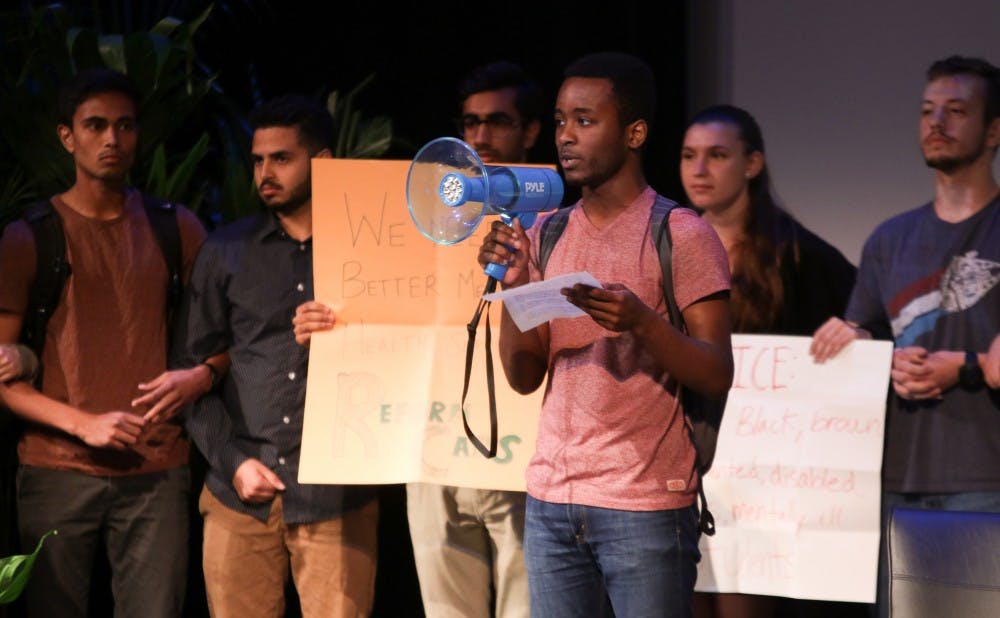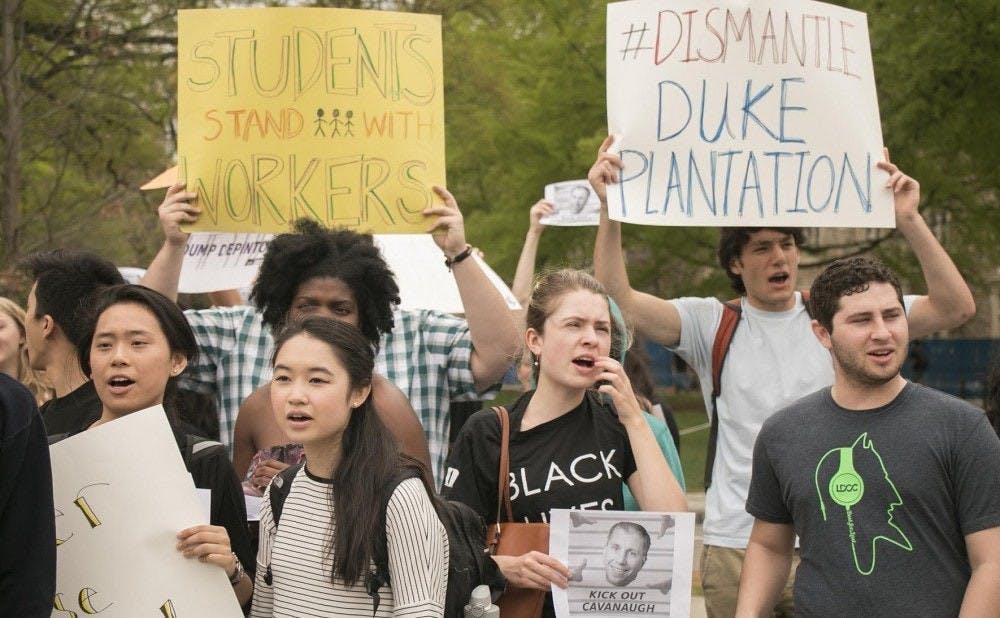Duke’s history is rife with student protests that echo one another, spanning from civil rights sit-ins to anti-ICE flyers.
On Jan. 23, Duke students protested at a TechConnect networking event in Penn Pavilion. This comes after a protest last semester that criticized Duke administration for allowing Palantir, a tech company involved with U.S. Immigration and Customs Enforcement, to recruit on campus.
However, these protests are not new to Duke’s campus and reflect the University’s long history with student activism driving social change.
Historic protests for civil rights
Martin Luther King Jr. was assassinated in Memphis, Tenn., April 4, 1968, afflicting the nation with anger and fear. In response, Duke saw the development of what would become the Silent Vigil—the largest protest in University history.
At first, around 450 students participated in a march to President Douglas Knight’s house. Demands by the students included raising the minimum wage and allowing collective bargaining rights for non-academic workers at Duke, many of whom were black.
A silent demonstration then began in front of the Chapel, reaching about 2,000 protesters in three days.
The demonstration lasted until April 12 and remained nonviolent. Participants did not speak except for occasional announcements.
In response to the demonstration, Duke gradually increased wages and created two committees to analyze the University’s treatment of non-academic employees.
During the Silent Vigil, several students on campus wanted to occupy the Allen Building as another form of protest, but they initially did not find a large following. However, less than a year later, between 50 and 75 Duke students—mostly members of the Afro-American society—barricaded themselves on the first floor of the Allen Building, the main administrative building on West Campus. Feb. 13, 1969, marked the first day of the Allen Building Takeover.
Protesters emphasized the needs of African Americans at Duke, including the creation of an African American studies department and stronger protection from police harassment.
Later in the afternoon, around 1,500 students decided to surround the Allen Building in support of the protesting students. The sit-in protesters left the building peacefully around 5:15 pm.
However, violence soon erupted on West Campus, as the crowd was tear-gassed by police after a protester apparently threw a rock at the helmet of an officer. Anarchy broke out for the next hour and a half.

Following the protest, a resolution was approved March 13 to create a Supervisory Committee for “a program in African and Afro-American studies” at Duke.
Disciplinary charges were filed against 25 students who conducted the protest due to their violations of the Pickets and Protest Policy. After a trial by a five-member hearing committee, 47 of the protesters received one year of probation.
President Douglas Knight resigned March 31, and Terry Sanford was named the new president in December.
The Silent Vigil and Allen Building Takeover were fundamental protests that influenced future protests following the anti-war era.
In 1975, the Association of African Students presented a list of demands to administrators that included increasing the number of black faculty members on campus and departmentalizing the Black Studies Program.
The group quietly gathered outside the Allen Building. A group of about 100 students then entered the building and brought lists of demands to administrative offices on the second floor before silently exiting.
The anti-war era
In addition to these two fundamental demonstrations, the late 1960s featured strong anti-war sentiment across different university organizations.
In 1966, the Student Nonviolent Coordinating Committee issued a statement publicly condemning the Vietnam War. They believed that the U.S. was hypocritical in repressing the freedoms of black Americans while fighting for the freedom of the Vietnamese people.
The Chronicle’s Editorial Board released an article Jan. 30, 1969 describing Duke as “an insensitive agent of imperialism, racism and poverty.” They stated that “for university credit, students are trained to kill and are indoctrinated with blind patriotism in the ROTC.”
The Student Liberation Front, an umbrella organization for new- and old-left political thought with about 200 members, released a paper April 1969 condemning Duke for its ROTC programs and for accepting research funds from the Department of Defense.
This organization led a demonstration at Duke’s yearly ROTC parade May 1969, demanding that ROTC be removed from Duke campus by Oct. 1.
A year later, 200 students presented President Sanford with a list of demands, including “the end of all military influence on campus” and “an end to the repression of all workers, especially the ‘super-repression’ of blacks and women at Duke.”
On this same day, students participated in a multitude of anti-war demonstrations, from boycotting classes to barricading Duke University Road from morning to evening.
Anti-war demonstrations continued on campus until 1975. Along the way, Duke administration gave in to several of the protesters’ demands, including placing restrictions on the number of military courses that counted towards graduation and ending contracts with the Army Research Office—Durham.
Contemporary protests echo the past
In February 2016, a Duke parking attendant filed allegations against Executive Vice President Tallman Trask, claiming that he hit her with his car and called her a racial slur. Trask apologized for hitting her, but has denied the allegations of using a racial slur.
Duke Students and Workers in Solidarity responded with a week-long sit-in in the Allen Building.
The students had seven demands, including the “immediate termination, without compensation, of [Trask], [Vice President of Administration] Kyle Cavanaugh, and [Parking & Transportation] Director Carl DePinto.”
Others tented for almost a month in the quad outside of the Allen Building, known as Amnesty-Ville or A-Ville at the time.
In April 2018, 25 undergraduate Duke students, calling themselves the People’s State of the University, rushed the stage in Page Auditorium as President Vincent Price prepared to accept class gifts at an alumni event.

The first student to take the megaphone was then-junior Trey Walk, who emphasized the Silent Vigil as a primary motivation for the demonstration.
“These events would later be summarized as a turning point for Duke, but 50 years later, so much has still remained the same,” Walk said on stage. “We are still here.”
Price did not interject as the protesters shouted their demands into the microphone. These demands included need-blind admissions for international students and publicly open Board of Trustees meetings.
Since the protest, PSOTU pushed for their demands by holding meetings with administration, running campaigns and promoting ongoing discourse about prevailing issues on campus.
PSOTU is no longer active, but they succeeded in having a few of their demands met, including Duke “banning the box” on employment applications and renaming what was formerly the Carr Building on East Campus.
Duke students also utilize protests as a means of holding other students accountable for actions that do not meet community standards of respect and tolerance.
In early 2013, around 200 students protested against Duke’s Kappa Sigma fraternity because of an “Asia Prime” themed party with stereotypical representations of Asian culture. The parent organization suspended its Duke chapter shortly after the protests.
The future of protesting
Duke students disagree about the extent to which protest culture on campus exists today.
According to sophomore Jeremy Carballo, who is on The Chronicle’s Community Editorial Board, protests at Duke are relatively infrequent.
“Duke students are too caught up with their own lives to organize collective action,” Carballo wrote in an email.
First-year Lily Levin, a columnist for The Chronicle, however, thinks that Duke administration is partially responsible for the stereotype of political apathy on campus.
“Durham is viewed as ‘unsafe’ by outsiders—which is often racialized—but is undergoing mass gentrification,” Levin wrote in an email to The Chronicle. “There’s definitely a deep and historic divide between Duke and Durham, which is mostly due to Duke administration, and while that stereotype may apply to some students, many are attempting to work in the community and engage in political action.”
Additionally, although PSOTU is no longer active, sophomore Musa Saleem, a member of the Community Editorial Board, said that some students are hoping to start a similar group in the future to organize rapid action and continuing discourse around these structural issues.
“People’s State set up a good precedent in terms of organizing action on campus and many people want to continue this work in whatever form in the future,” Saleem said.
Mona Tong contributed reporting.
Editor's Note: An earlier version of this article incorrectly referred to the Kappa Sigma parent organization as Sigma Kappa. The Chronicle regrets the error.
Get The Chronicle straight to your inbox
Signup for our weekly newsletter. Cancel at any time.

Leah Boyd is a Pratt senior and a social chair of The Chronicle's 118th volume. She was previously editor-in-chief for Volume 117.

